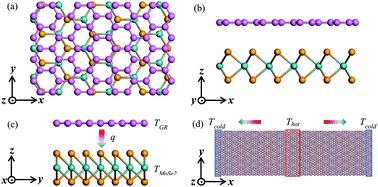Phonon thermal transport in a graphene/MoSe2 van der Waals heterobilayer
Abstract
Combining the best of different monolayers in one ultimate van der Waals (vdW) heterostructure is an appealing approach for practical applications. Recently, a graphene (GR) and molybdenum diselenide (MoSe2) heterobilayer was successfully fabricated experimentally. The superior electrical conductivity of GR combined with the unique photoelectrical properties and direct bandgap of MoSe2 can yield many potential applications, such as Li-ion batteries, tunneling field effect transistors and two-dimensional non-volatile memory devices. Efficient heat conduction within the device components is of great importance for nanoelectronic performance. In this work, the cross-plane interfacial thermal resistance (R) and in-plane thermal conductivity (κ) of the GR/MoSe2 vdW heterobilayer are systematically investigated using classical molecular dynamics (MD) simulations. The predicted R at a temperature of 300 K is equal to 1.91 × 10−7 K m2 W−1. Effects of several modulators such as temperature, contact pressure and vacancy defects are evaluated, which are all found to have negative correlations with the calculated interfacial thermal resistance. The highest reduction of R amounts to 75% for doubled coupling strength between GR and MoSe2. Spectral energy density (SED) and phonon density of states (Ph-DOS) analyses are performed to gain further insights into the phonon properties of GR and MoSe2. Our study provides reasonable guidelines to increase heat dissipation efficiency for future GR/MoSe2 based applications.

- This article is part of the themed collection: 2018 PCCP HOT Articles


 Please wait while we load your content...
Please wait while we load your content...